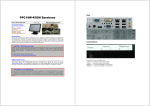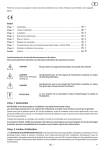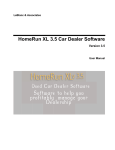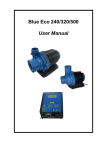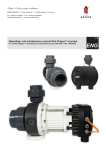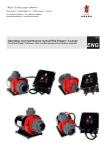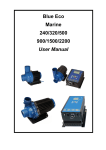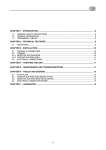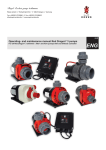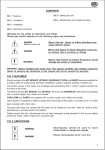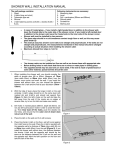Download SCM SA6 GB
Transcript
GB CONTENTS Ch. Ch. Ch. Ch. 1 2 3 4 - Features Transportation and storage Limitations Motor assembly Ch. Ch. Ch. Ch. 5 6 7 8 - Electric pump installation Electric connection Starting the unit Maintenance and troubleshooting GENERAL SAFETY WARNING Warnings for the safety of individuals and things. Please pay careful attention to the following signs and indications. DANGER Warns that the failure to follow directions may cause electric shock. Electric shock risk DANGER Risk of bursting It indicates that the failure to comply with the instruction given can cause an explosion. DANGER Warns that failure to follow directions could cause serious risk to persons or things. WARNING It indicates that the failure to comply with the instruction given can damage the pump. WARNING: Before installing this pump read this manual carefully. Any damage caused by failure to observe any directions in this manual will not be covered by warranty. CH. 1 - FEATURES SCM 4 Plus®, SCM 4 HF and SA 6 pumps can be supplied with or without electric motor. This booklet supplies all the information concerning the use and maintenance of these machines. SCM 4 Plus®, SCM 4 HF and SA 6 pumps are submersed. The multi-stage pumping unit is directly coupled to the submersed electric motor. CH. 2 - TRANSPORT AND STORAGE Each machine is carefully tested and packed during the assembly phase. On receiving the pump, customers will have to verify: that the product complies with the data quoted in the order; that is has not suffered damages during transportation. All damages should be immediately reported to the distributor within 8 (eight) days from the date of purchase. Don't disperse and/or throw the packaging away and take all possible measures to re-use it and recycle it. Before transporting the unit, check the following data: - weight of the pump (or the pump end) - overall dimensions - lifting points The pump (or the pump end) has to be transported with equipment suitable to its weight and dimensions. Only pumps (or units) with a weight below 20 Kg can be transported manually. The units have to be stored in closed, dry and ventilated areas avoiding excessively low temperatures. If the units have to be stored for long periods of time (above 12 months) or in presence of low temperatures, it is necessary to rotate the shafts and the hydraulic unit at least once a month. Protect the terminals of the cables from humidity, making sure that these are not bent with curves above 6 times their diameter. If the single components are stored individually, protect the rubber parts and the thrust bearings from direct sun light. CH. 3 - LIMITATIONS SCM 4 Plus®, SCM 4 HF and SA 6 pumps are designed to pump clean water (for the food industry). 6 GB GB WARNING Electric pump cannot be used to move inflammable or dangerous liquids. WARNING Ensure electric pump never runs dry MAX. TEMPERATURE OF PUMPED LIQUID MAX. FREE PASSAGE MAXIMUM SAND QUANTITY MAX.ON/OFF CYCLES/HOUR MINIMUM WELL DIAMETER MAX. IMMERSION DEPTH 30° C (SCM 4 ®)-25° C (SA 6) 3 mm 50 g/m3 (SCM 4 ®)-40 g/m3 (SA 6) 20 (SCM 4 ®)-15 (SA 6) equally distributed 100 mm (SCM 4 ®)-150 mm (SA 6) 150 m CH. 4 - MOTOR ASSEMBLY DANGER Risk of electric shock When installing, please ensure unit is disconnected from electrical supply. SCM 4 PLUS®, SCM 4 HF and SA 6 pumps are designed to be coupled with 4" motors (SCM 4 PLUS®, SCM 4 HF and SA 6) and 6" motors (SA 6) in accordance with NEMA standards. Perform the following operations to guarantee a correct coupling: - remove the raceway that protects the cable and the sand-protection filter - manually check the rotation of the motor shaft and the hydraulic unit - verify that the coupling and the coupling axis are clean - join the pump body and the motor, verifying that the electric cable is correctly positioned next to grooves on the hydraulic unit supports - tighten the nuts on the 4 motor tie rods, alternatively on the diagonals - position the electric cable along the pump and reassemble the protection raceway by tightening the screws to the hydraulic unit - fix the sand protection filter to the lower support of the hydraulic unit body by using the screws provided for this purpose Before installing the hydraulic unit inside the well, it is necessary to remove all the sand, in accordance with the ordinary procedures adopted for perforators. SCM 4 PLUS®, SCM 4 HF and SA 6 pumps should never be used without pumping liquid, because the bearings are lubricated by the liquid itself. The pump can suffer severe damage if it is operated in dry conditions, even for short interval of time. The unit has to be positioned on the bottom of the well and slightly raised by approximately 1-2 m, to prevent the sand surrounding the motor and the pump and overheating the former and wearing the rotating parts of the latter. Before lowering the pump into the well, make sure that the supply cable have been correctly tightened to the fittings on the control panel and that the protection relays are suited to the absorption indicated on the nameplate. At this point, disconnect the unit and start lowering it into the well. All lowering operations should be performed using stainless steel or nylon ropes and the slots provided on the head of the pump. Connect the first pipe section to the drain mouth of the pump after fixing the two halves of the supporting rod to the end of the pipe. If threaded pipes are provided, apply the threaded sleeve to the upper end to avoid it sliding between the pipe and the rod. Use a hoist to lower the whole unit into the well. Carefully control the free end of the cable to prevent it falling into the well. Connect the second section of the pipe, that is coupled to the upper supporting rod, remove the previous rod and lower the whole unit into the well. Repeat this operation until the desired project depth has been reached. Take into account that the machine must be positioned at 1-2 m below the dynamic level or, at any rate, at a depth that meets the pump NPSH. Before positioning the pump, it is necessary to take into account the lowering of the water level, that can originate from seasonal factors or from an excessive stratum extraction. The well level should never fall below the suction chamber to avoid gripping the guide bushings and overheating the motor. The power cable should be fixed with straps every 2-3 m of pipe. Cables should be safely anchored to the riser to prevent lowering caused by weight. These movements could cause deformations owed to the striking against the walls of the well and ruptures of the cables. If the riser is formed by threaded tube sections, it is necessary to tighten the latter to prevent them coming loose due to the machine reaction torque. CH. 6 - ELECTRIC CONNECTION CH. 5 - ELECTRIC PUMP INSTALLATION (see fig. 1) DANGER Risk of electric shock When installing, please ensure pump is disconnected from electrical supply. DANGER Risk of electric shock Never use the electric cable to support the electric pump. DANGER Risk of electric shock Be careful not to damage the electric cable when lowering it into the well. DANGER Risk of bursting This type of pump can develop high pressure. If a collection tank or expansion tank 15 is to be installed, it is advisable to install a pressure limiter valve 16 between the tank and the pump. DANGER Risk of bursting All of the pipes and installation parts must have a maximum working pressure which is greater or equal to the maximum pressure of the pump, if this is not possible it is necessary to use a pressure reducer. WARNING Protect the electric pump and all pipes from freezing. 7 WARNING Ensure tension and frequency of pump (read plate) and power supply are same. DANGER Electric shock risk Installer must make sure that electric current network has ground wire conforming to current laws. DANGER Electric shock risk Make sure that electric current network is provided with a high-sensitivity circuit breaker , =30 mA (DIN VDE 0100T739) WARNING Before connecting the power supply cord to the clamps on the command panel, make sure that the cord is able to withstand the nominal current of the unit. Electric connections must be carried out by skilled staff only, in accordance with the manufacturer's instructions enclosed to the electric equipment and the motor. It is advisable to install a protection device upstream, of adequate dimensions (in accordance with the current values indicated on the nameplate) to prevent voltage peaks and overloads. Cables should be selected in function of the absorption in Ampere, indicated on the nameplate. Cables should be dimensioned in accordance to the power to transmit, of the distance from the control page and the starting system of the submersed motor. Cables should guarantee a submersed operation, have waterproof joints and show no signs of abrasions or holes. The control board should be equipped with all the protection devices and equipment to manage and drive the hydraulic unit. More specifically, it is necessary to guarantee a protection against overcurrent and short circuits. Protections against the loss of phases, the lowering of voltage and the lack of water in the well are recommended but not compulsory. 8 GB GB CH. 7 - STARTING THE UNIT WARNING Use the hydraulic unit within the operating limits indicated on the nameplate or the datasheet. WARNING Never run the pump in dry conditions, even for short intervals of time. WARNING Do not run the pump with the interception valve on delivery completely closed. WARNING Do not run the pump in the opposite direction for more than 30 seconds. WARNING Complete all the electric and mechanic connections before starting the pump. Before lowering the pump into the well it is necessary to control the direction of rotation of the motor to avoid damaging the thrust bearing. If the direction of rotation is correct, the hydraulic performances of the pump are compliant with those indicated in the catalogue. To perform this check it is necessary to start the pump with a partially opened gate. When the water starts flowing in, further close the gate and verify that the pressure value is above the one indicated on the nameplate. If this not occurs, the motor is rotated in the opposed direction. To resume the correct direction of rotation, invert the two phases on the control panel. The motor of the pump should not rotate in the opposite direction for above 30 seconds. After verifying the direction of rotation, allow the pump to run reducing the opening of the valve to about half the maximum opening, for about one minute. Stop the pump to remove gas pockets from the hydraulic unit, since their presence could prevent the correct lubrication of the shaft. This interval should always be below 5 minutes. After performing this operation, restart the machine by gradually opening the delivery valve until all the sand has been removed or has reached minimum levels (40 g/m3). If the well has been built and drained correctly, this operation can be performed in about 20 minutes. After the completion of this phase, it is possible to connect the delivery hose of the pump. Before starting the pump is final mode, check: - the continuity of the electric circuit to make sure that no damages have occurred during the lowering in the well - the insulation resistance to ground, that is the related value between the cable terminals and the drainage pipe - the performances of the pump, that should always be within the operating range - the value of the current supplied to the control board, that should always be below the one indicated on the motor nameplate If necessary, partially open the gate or adjust the pressure switches. If abnormal operating conditions are reported during the start-up phase, stop the machine, establish the cause and remove the pump from the well, if necessary. PROBLEM POSSIBLE CAUSE 1) Check that there is electricity and verify voltage with data on motor plate. 2) Correctly connect the control panel. THE PUMP STARTS, THE FUSES 1) Low voltage TRIP AND THE STARTER 2) Overload originating from sand RELAYS ARE ENABLED clogging. Bearings tend to block 3) The current that passes through the windings is 1.5-2 above the rated value (single-phase versions) 4) The differential switch has tripped. 5) The pump is blocked in a non perfectly vertical well 1) Increase the diameter of the supply line. 2) Extract the pump, repair it and clean it. THE PUMP STARTS TOO OFTEN 1) Leakage in the installation. 2) Electric pump capacity too high with respect to the well (level probes intervene). 1) Find leak and repair it. 2) Reduce amount of incoming water from source. DANGER Electric shock risk Before doing any operation, make sure machine is disconnected from electric power supply. Periodical maintenance should be performed according to the content of sand in water. In ordinary conditions, SCM 4 Plus®, SCM 4 HF and SA 6 pumps do not require servicing. To prevent possible failure, it is advisable to periodically control the flow rate and current absorption. A fall below 50% in the flow rate, as compared to the rated value, indicates that the pump is worn. Similarly, an increase of the current absorption above 5% indicates the presence of abnormal mechanical failures in the pump and/or motors. In many cases, it is necessary to replace the worn parts, like impellers, O-rings and bearings. If the content of sand in pumped water is high, it is advisable to inspect the pump for the first time after about one thousand operating hours. If the pump is left idle in the well for long intervals of time, it is advisable to start it and allow it to run for a short time every 2-3 months. Always make sure that the unit is completely submersed. 9 3) Check the voltage on the phases, inspect the condition of the fuses and of the starter contacts. 4) Reset the switch. If the switch continues to trip, contact a qualified electrician 5) Move the pump to the correct position and restart it. 3) Adjust calibration. 4) Tank saturated with water. 5) Autoclave tank too small. 4) Restore correct tank functioning. 5) Replace the tank. THE PUMP YIELDS LOW FLOW 1) IIncorrect direction of rotation RATES AND HEADS (three-phase versions) 2) Leakage in the installation. 3) Filter is clogged or sand in electric pump. 4) Electric pump worn out. THE PUMP DOESN'T PROVIDE 1) The water level in the well is WATER lower than the suction level or the stratum has lowered 2) The valves are blocked or positioned in the opposite direction 3) Leaks in the delivery hose 4) Pump or suction filter clogged with sand 5) Incorrectly calculated load losses 6) Worn pump 7) The voltage is below the rated value and the absorption is higher than usual 8) The absorbed current is below ordinary values because of the presence of air inside the pump 10 3) Remove obstacle from electric pump. 4) Use an Ohmmeter to control the continuity of the electric system 5) Reset switch, if it trips again call a qualified electrician. 3) Pressure switch not correctly calibrated (use with autoclave). 5) The pressure head has been incorrectly calculated CH. 8 - MAINTENANCE AND TROUBLESHOOTING REMEDY THE PUMP DOESN'T START, 1) No voltage or incorrect voltage. BUT THE FUSES TRIP AND THE 2) The command panel is not STARTER RELAYS CANNOT BE connected properly. ENABLED 3) The pump is blocked. 4) Interrupted circuit in the cable or motor winding 5) The differential switch has tripped. 1) Reverse two power supply phases in the command panel. 2) Find leak and repair it. 3) Remove the unit and clean the filter. 4) Extract the pump, inspect it and replace the worn parts or the pump 5) Revise calculations and replace the pump, if necessary 1) Check the stratum level during the pump operation and reposition the pump into the well 2) Check the valves. If they are blocked, slightly hit the delivery line in the attempt of moving the valve 3) Inspect the line, find possible leaks and repair them 4) Extract the pump and clean the filter and the parts clogged with sand 5) Revise the calculations and use a hose with a larger diameter or replace the pump 6) Replace the pump 7) Increase the voltage. Increase the diameter of the supply cable 8) Start the pump and stop it at intervals of about one minute



